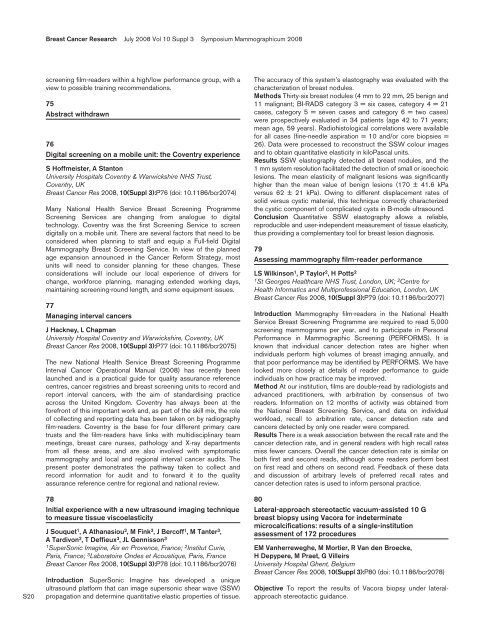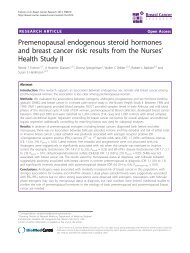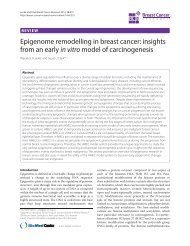Ultrasound-guided axillary node core biopsy - Breast Cancer ...
Ultrasound-guided axillary node core biopsy - Breast Cancer ...
Ultrasound-guided axillary node core biopsy - Breast Cancer ...
You also want an ePaper? Increase the reach of your titles
YUMPU automatically turns print PDFs into web optimized ePapers that Google loves.
<strong>Breast</strong> <strong>Cancer</strong> Research July 2008 Vol 10 Suppl 3 Symposium Mammographicum 2008<br />
S20<br />
screening film-readers within a high/low performance group, with a<br />
view to possible training recommendations.<br />
75<br />
Abstract withdrawn<br />
76<br />
Digital screening on a mobile unit: the Coventry experience<br />
S Hoffmeister, A Stanton<br />
University Hospitals Coventry & Warwickshire NHS Trust,<br />
Coventry, UK<br />
<strong>Breast</strong> <strong>Cancer</strong> Res 2008, 10(Suppl 3):P76 (doi: 10.1186/bcr2074)<br />
Many National Health Service <strong>Breast</strong> Screening Programme<br />
Screening Services are changing from analogue to digital<br />
technology. Coventry was the first Screening Service to screen<br />
digitally on a mobile unit. There are several factors that need to be<br />
considered when planning to staff and equip a Full-field Digital<br />
Mammography <strong>Breast</strong> Screening Service. In view of the planned<br />
age expansion announced in the <strong>Cancer</strong> Reform Strategy, most<br />
units will need to consider planning for these changes. These<br />
considerations will include our local experience of drivers for<br />
change, workforce planning, managing extended working days,<br />
maintaining screening-round length, and some equipment issues.<br />
77<br />
Managing interval cancers<br />
J Hackney, L Chapman<br />
University Hospital Coventry and Warwickshire, Coventry, UK<br />
<strong>Breast</strong> <strong>Cancer</strong> Res 2008, 10(Suppl 3):P77 (doi: 10.1186/bcr2075)<br />
The new National Health Service <strong>Breast</strong> Screening Programme<br />
Interval <strong>Cancer</strong> Operational Manual (2008) has recently been<br />
launched and is a practical guide for quality assurance reference<br />
centres, cancer registries and breast screening units to record and<br />
report interval cancers, with the aim of standardising practice<br />
across the United Kingdom. Coventry has always been at the<br />
forefront of this important work and, as part of the skill mix, the role<br />
of collecting and reporting data has been taken on by radiography<br />
film-readers. Coventry is the base for four different primary care<br />
trusts and the film-readers have links with multidisciplinary team<br />
meetings, breast care nurses, pathology and X-ray departments<br />
from all these areas, and are also involved with symptomatic<br />
mammography and local and regional interval cancer audits. The<br />
present poster demonstrates the pathway taken to collect and<br />
record information for audit and to forward it to the quality<br />
assurance reference centre for regional and national review.<br />
78<br />
Initial experience with a new ultrasound imaging technique<br />
to measure tissue viscoelasticity<br />
J Souquet 1 , A Athanasiou 2 , M Fink 3 , J Bercoff 1 , M Tanter 3 ,<br />
A Tardivon 2 , T Deffieux 3 , JL Gennisson 3<br />
1 SuperSonic Imagine, Aix en Provence, France; 2 Institut Curie,<br />
Paris, France; 3 Laboratoire Ondes et Acoustique, Paris, France<br />
<strong>Breast</strong> <strong>Cancer</strong> Res 2008, 10(Suppl 3):P78 (doi: 10.1186/bcr2076)<br />
Introduction SuperSonic Imagine has developed a unique<br />
ultrasound platform that can image supersonic shear wave (SSW)<br />
propagation and determine quantitative elastic properties of tissue.<br />
The accuracy of this system’s elastography was evaluated with the<br />
characterization of breast nodules.<br />
Methods Thirty-six breast nodules (4 mm to 22 mm, 25 benign and<br />
11 malignant; BI-RADS category 3 = six cases, category 4 = 21<br />
cases, category 5 = seven cases and category 6 = two cases)<br />
were prospectively evaluated in 34 patients (age 42 to 71 years;<br />
mean age, 59 years). Radiohistological correlations were available<br />
for all cases (fine-needle aspiration = 10 and/or <strong>core</strong> biopsies =<br />
26). Data were processed to reconstruct the SSW colour images<br />
and to obtain quantitative elasticity in kiloPascal units.<br />
Results SSW elastography detected all breast nodules, and the<br />
1 mm system resolution facilitated the detection of small or isoechoic<br />
lesions. The mean elasticity of malignant lesions was significantly<br />
higher than the mean value of benign lesions (170 ± 41.6 kPa<br />
versus 62 ± 21 kPa). Owing to different displacement rates of<br />
solid versus cystic material, this technique correctly characterized<br />
the cystic component of complicated cysts in B-mode ultrasound.<br />
Conclusion Quantitative SSW elastography allows a reliable,<br />
reproducible and user-independent measurement of tissue elasticity,<br />
thus providing a complementary tool for breast lesion diagnosis.<br />
79<br />
Assessing mammography film-reader performance<br />
LS Wilkinson 1 , P Taylor 2 , H Potts 2<br />
1 St Georges Healthcare NHS Trust, London, UK; 2 Centre for<br />
Health Informatics and Multiprofessional Education, London, UK<br />
<strong>Breast</strong> <strong>Cancer</strong> Res 2008, 10(Suppl 3):P79 (doi: 10.1186/bcr2077)<br />
Introduction Mammography film-readers in the National Health<br />
Service <strong>Breast</strong> Screening Programme are required to read 5,000<br />
screening mammograms per year, and to participate in Personal<br />
Performance in Mammographic Screening (PERFORMS). It is<br />
known that individual cancer detection rates are higher when<br />
individuals perform high volumes of breast imaging annually, and<br />
that poor performance may be identified by PERFORMS. We have<br />
looked more closely at details of reader performance to guide<br />
individuals on how practice may be improved.<br />
Method At our institution, films are double-read by radiologists and<br />
advanced practitioners, with arbitration by consensus of two<br />
readers. Information on 12 months of activity was obtained from<br />
the National <strong>Breast</strong> Screening Service, and data on individual<br />
workload, recall to arbitration rate, cancer detection rate and<br />
cancers detected by only one reader were compared.<br />
Results There is a weak association between the recall rate and the<br />
cancer detection rate, and in general readers with high recall rates<br />
miss fewer cancers. Overall the cancer detection rate is similar on<br />
both first and second reads, although some readers perform best<br />
on first read and others on second read. Feedback of these data<br />
and discussion of arbitrary levels of preferred recall rates and<br />
cancer detection rates is used to inform personal practice.<br />
80<br />
Lateral-approach stereotactic vacuum-assisted 10 G<br />
breast <strong>biopsy</strong> using Vacora for indeterminate<br />
microcalcifications: results of a single-institution<br />
assessment of 172 procedures<br />
EM Vanherreweghe, M Mortier, R Van den Broecke,<br />
H Depypere, M Praet, G Villeirs<br />
University Hospital Ghent, Belgium<br />
<strong>Breast</strong> <strong>Cancer</strong> Res 2008, 10(Suppl 3):P80 (doi: 10.1186/bcr2078)<br />
Objective To report the results of Vacora <strong>biopsy</strong> under lateralapproach<br />
stereotactic guidance.






